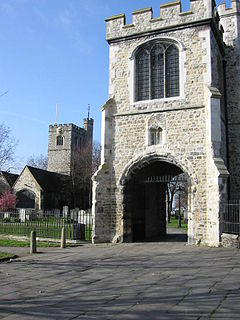Barking
Barking is a suburban area of east London, England and the administrative headquarters of the London Borough of Barking and Dagenham. It is located 8.8 miles (14.2 km) east of Charing Cross and is one of 35 major centres identified in the London Plan.[1] It was historically a fishing and agrarian settlement in the county of Essex and formed an ancient parish. The economic history of Barking is characterised by a shift to market gardening, and industrial development to the south adjacent to the River Thames. The railway station opened in 1854 and was served by electric London Underground services from 1908. As part of the suburban growth of London in the 20th century, Barking significantly expanded and increased in population, primarily due to the development of the London County Council estate at Becontree in the 1920s, and became a municipal borough in 1931. It has formed part of Greater London since 1965. In addition to an extensive and fairly low density residential area, the town centre forms a large retail and commercial district, which is currently a focus for regeneration.[2] The former industrial lands to the south are also being redeveloped as Barking Riverside.Toponymy Its name came from Anglo-Saxon Berecingas, meaning either "the settlement of the followers or descendants of a man called Bereca" or "the settlement by the birch trees". "Barking", in English slang, is short for "barking mad". Barking is sometimes cited as the origin of the phrase. This is attributed to the alleged existence of a medieval insane asylum attached to Barking Abbey. However, the phrase is not medieval, and first appeared only in the 20th century.[4] A more likely derivation is from comparing an insane person

to a mad dog.[5] [edit]Local government Barking was a large ancient parish of 12,307 acres (49.80 km2) in the Becontree hundred of Essex. It was divided into the wards of Chadwell, Ilford, Ripple and Town. A local board was formed for Town ward in 1882 and it was extended to cover Ripple ward in 1885. In 1888 Ilford and Chadwell were split off as a new parish of Ilford, leaving a residual parish of 3,814 acres (15.43 km2).[6] The parish became Barking Town Urban District in 1894 and the local board became an urban district council. The urban district was incorporated as the Municipal Borough of Barking in 1931. It was abolished in 1965 and split with the majority merged with the former area of the Municipal Borough of Dagenham to form the London Borough of Barking. Barking land that was west of the River Roding, which included part of Beckton, became part of the London Borough of Newham. In 1980 the Borough was renamed Barking and Dagenham.[7] [edit]Urban development The manor of Barking was the site of Barking Abbey, a nunnery founded in 666 by Eorcenwald, bishop of London, destroyed by the Danes and reconstructed about a hundred years later in 970 by King Edgar. At the Dissolution of the Monasteries in 1536, Barking Abbey was demolished; apart from the parish church of St Margaret, some walling and foundations are all that otherwise remain on the site. The church is an example of Norman architecture; Captain James Cook married Elizabeth Batts of Shadwell there in 1762, and it is the burial place of many members of the Fanshawe family of Parsloes Manor. A charter issued between 1175 and 1179 confirms the ancient market right. The market declined in the 18th century but has since been revived.